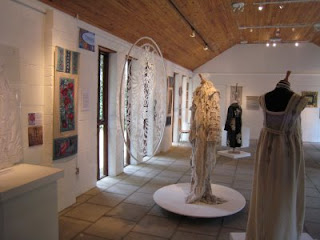
We travelled to Vamberk for the biennial lace meeting and exhibition from 26 to 30 June 2008. We stayed at the Hotel Havel in Rychnov and this piece by Eva Filarova is in the hotel lobby there. There were several interesting international stands at the meeting and an exhibition by Marina Regueiro, Maria Bissacco Cociani, and Jana Stefkova. Marina showed traditional Spanish lace, Maria exhibited some lovely shawls, bags and clothes decorated with lace, and Jana showed some of her work including her head pieces made of interesting braids, some of which I sketched in the Museum.













